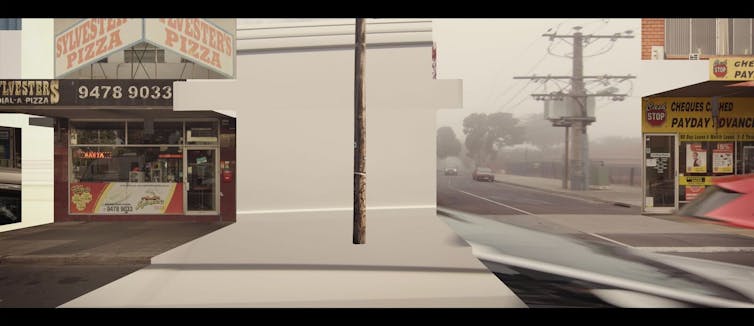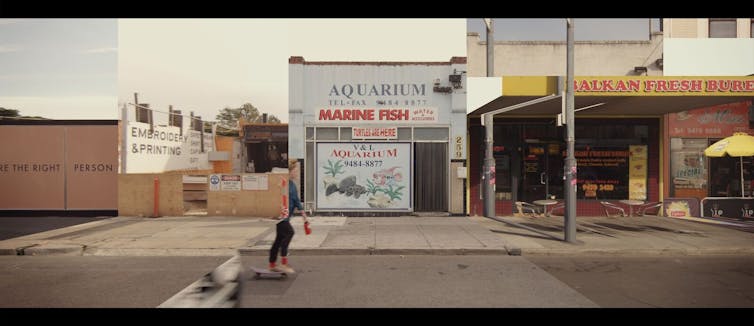High Street (After Ruscha) ruminates on memory, community and culture
- Written by David Nichols, Senior Lecturer - Urban Planning, University of Melbourne
Daniel Crooks’ High Street (After Ruscha) is easily described yet by no means simple. A 17-minute video, it pans along the preposterously unimaginatively named – and in many respects generic to type – High Street, Preston in Melbourne’s northern suburbs. The plane of the street is, however, broken frequently by interposed, faster, vehicle traffic cutting across or behind the buildings and pedestrians.
In doing so, the visual connection between composition elements is disturbed, and Crooks makes decisions about what will be grouped as a unit: a building and the road in front of it, perhaps, or a row. Other random urban features – a long, abrupt, epic suburban street or a smaller laneway perpendicular to High, for instance – appear periodically, disturbing the slow motion. This is presented to a synthesized ambient soundtrack – over which only the cars, ploughing past, are audible – latterly building to a crescendo.
 Daniel Crooks, High Street (After Ruscha), 2017 (still). Single channel video, 2:1, 4K, stereo, 17 minutes 52 seconds.
Courtesy the artist and Anna Schwartz Gallery.
Daniel Crooks, High Street (After Ruscha), 2017 (still). Single channel video, 2:1, 4K, stereo, 17 minutes 52 seconds.
Courtesy the artist and Anna Schwartz Gallery.
Playing, as it is, upstairs at Anna Schwartz Gallery, the video is visited by patrons engaging with brief snatches or absorbing the whole; at either end, the streetscape is revealed to be a vast platform in a black void, like a spaceship perhaps or – as it is probably meant to be – a memory snapshot.
High Street, which Crooks describes as “on the cusp of a major change”, is filled with specialty businesses Melbourne is just big enough to sustain, such as the Zagreb Croatian Bookshop, and the very local bordering on generic, such as Ottas Fish and Chips.
The work is, in part, a commentary on time; the vehicles speeding much faster than the camera (and viewer) are forces of the future, and it is all we can do to prevent them dragging us forward in their wake. It is also a rumination on memory, community and culture.
It is – naturally – entirely within an artist’s province to depict, outline, extemporize or analyse urban community, place and character. It is curious nonetheless that Crooks talks about this High Street as a document (Edward Ruscha’s Every Building on the Sunset Strip is his reference point) particularly given that he has chosen to distort the streetscape so that the bottom third of the screen stretches outwards towards the viewer. The legs of children, women and men walking the pavement are distended towards us at angles, and some items – street signs, for instance – are duplicated surrealistically.
 Daniel Crooks, High Street (After Ruscha), 2017 (still). Single channel video, 2:1, 4K, stereo, 17 minutes 52 seconds.
Courtesy the artist and Anna Schwartz Gallery.
Daniel Crooks, High Street (After Ruscha), 2017 (still). Single channel video, 2:1, 4K, stereo, 17 minutes 52 seconds.
Courtesy the artist and Anna Schwartz Gallery.
Through this change we gain an altered (though not deceptive – the distortion is overt) sense of the space of the road and its volume. While Ruscha’s 1966 concertinaed photobook is the acknowledged inspiration for High Street, the work shares conceptual building blocks with Robert Rooney’s early 1970s constructions, particularly his serial “moment in time” photographs of mundane Melbourne streets. Notably, some of Rooney’s best known work depicts his very local environment, the middle-ring suburb of Hawthorn; Crooks lives in Preston.
So, while it does not behoove an (urban or other) historian to criticise a work of art – especially one as technically impressive and affecting as High Street – on the grounds of its accuracy, it remains true that Crooks has manipulated the streetscape. While many of its diverse buildings are lovingly detailed, this film is only a distant cousin to documentary.
Crooks’ feel for the street, and broadly speaking the implications of the automobile traffic that comes between the shops and the viewer, is evident. It is only in Claire Watson’s exhibition flyer that we are told of Crooks’ belief that the street is soon to fall to “high-rise apartments and trendy hipster cafés”.
This expectation – perhaps inspired by recent controversies attending plans for a partial redevelopment of a car park near High Street into apartments – is undoubtedly valid, but the disinterested viewer would be unlikely to see it as inherent to the piece.
Additionally, to describe this scene as one in which “gentrification has not yet taken its unmistakeable hold” is to tell only a part of the story. Artists living in, writing about, and memorializing environments are not even the first step of a cycle. For many, including Crooks, the multicultural streetscape, which he and Watson describe as distinct from the gentrification process, is as integral to that process as the last half-empty, high-end High Street apartment block before the next inevitable economic slump.
The “real”, non-trendy hipster residents of Preston relocate to another part of town, waiting until capital recovers, marshals its resources and looks for fresh fields to conquer with renewal and replenishment. There, and then, decades in the future, another Daniel Crooks will discover, appraise and seek to commemorate a disappearing cultural entity, set sadly to be recycled in the name of progress and/or profit.
The exhibition High Street (After Ruscha) by Daniel Crooks will be on view until 2 June 2018 at Anna Schwartz Gallery, 185 Flinders Lane, Melbourne, Australia.
Authors: David Nichols, Senior Lecturer - Urban Planning, University of Melbourne
Read more http://theconversation.com/high-street-after-ruscha-ruminates-on-memory-community-and-culture-96918



















